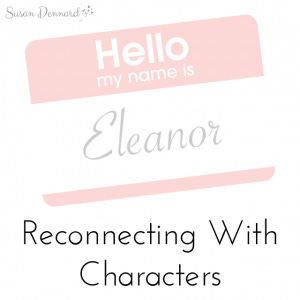Reconnecting with Characters

Last week, I got another great question in the Misfits & Daydreamers forum (ask your own questions if you have any!):
See, I move around / travel quite a bit...[and] something happens while I’m traveling that breaks / weakens my connection with the characters... I end up writing absolute rubbish, just forcing my characters — these strangers — down plots and crossroads. SO, my question is: How did you reconnect with your characters?
Okay. Awesome question because losing touch with characters happens to me—and other authors—all the time. Any instance in which you step away from a project for a while, you run this risk. Or, if you're starting up a sequel after being away from the previous book for a long bit, you might find reconnecting to your cast a bit tricky. (Uh, this was me every time I started a new SS&D book). I'll be honest, it will often happen that I don't even realize I've lost touch. I'll hand off a chunk of pages to a CP, and the CP will be like, "Erm...who is this character? What happened to the character I was reading about ?" Or, I'll be in a situation where I'm all, "I've been away so long, who are these people and what are they doing with their lives?!?!" When I come against this wall (or once I realize I'm against this wall), I do 2 things:
1. Recreate the Original Mood
First, I listen to the music that I associate with that character/story. So, for example, I've been (as mentioned in my Monday blog post) having one heck of a time rewriting my ending for Truthwitch. Even once I'd found my characters, I STILL wasn't totally sure what they'd do in certain situations. When faced with the "how the heck will Safi react here?" question, I put on the music that I associate with her character.
I literally listened to that song 6 times in a row and became Safi. I saw the situation through her eyes and tried to feel my way through it as if I were her. By the sixth round of the song, I had my scene figured out (roughly, at least). I was back in her head and I knew who she was. A friend of mine takes a similar approach before she writes a scene—she'll silence the world, close her eyes, and spend a few minutes settling into her character. She refers to it as a sort of meditation, and once she opens her eyes she's ready to write. But even still, sinking into our characters doesn't always work. We might still write something out-of-whack, or we not even be able to sink into the character! He/she might be so foreign to us, we don't know who he/she is anymore. When that happens, I...
2. Ask for Help (or line up your dominoes!)
If you've followed me for very long, then you know how close I am with Sarah J. Maas. In addition to being best friends, we do most of our writing in a very collaborative way. In fact, last week, we talked every single day for several hours (each day). Not about life or gossip or anything like that but about our characters. We're both struggling with this problem right now—we've lost touch with our characters and how they act. This problem happens; we both know it happens; and we both know that there's no reason to pretend we don't need help. So when Sarah writes a scene, I read it and tell her if it rings true. If it doesn't ring true, I tell her how I think the character would react. Sometimes my ideas are exactly what she needs, and other times my ideas will help spark the right ideas for her. When I write a scene, Sarah reads it and tells me if it rings true. If it doesn't, she tells me what she thinks the character would react. Sometimes her ideas are exactly what I need, and other times her ideas will help spark the right ideas for me. I realize not everyone is blessed with a soul-twin/critique partner who can intuitively see what you were trying to do. (We're lucky; trust us: we know.) But I think you can recreate what a critique partner does in this situation. First, though, let me explain WHY a CP can spot what we, the authors, cannot... Critique partners are able to intuitively see things we can't because they aren't as deeply mired in the story. They are outsiders to our stories, so they have a much clearer vision of how what's written on this page connects connects to what they read before. That's all the CP (or reader) has to keep track of. A single linear progression of stuff. We (the authors), however, have to keep track of the 25 plot threads (in this book...and the 47 in the other books), the 207 character arcs, the 506 settings, and how it ALL weaves together to interact and tie up. It's easy to get buried beneath all that stuff your brain has to consider. And because it's so easy to get bogged down, we lose track of the characters' personalities and growth (which is, I think, the most complex and difficult part of any story). Notice I said CPs keep track of "a single linear progression of stuff." You know what sounds like? YEP. Dominoes. By evaluating your dominoes, you can recreate what a CP does. Now, I know I keep talking about dominoes lately, but seriously! Your ability to understand your story will transform when you pull things apart and look at them in order—especially if you're dealing with multiple POVs. When we pull out our characters and look at their individual dominoes, we can hone in on ONE THING AT A TIME. Clear out the noise and see what a CP sees naturally. Oh, Eleanor acts X way here, then x way here, then x way here. Ahhhh, I think I see who she is again...More importantly, based on her choices/reactions earlier in the book, this is how she will choose/react in the next scene. I realize it's easier said than done to take apart the dominoes, but scene cards or Scrivener can greatly help with that task. I like to also write up a summary sentence of the character's emotions in each scene so I can get an easy, bird's-eye-view of the whole arc. Okay, so I realize that might have only confused you all more, so feel free to ask questions in the comments or forum. :) Also, don't forget to sign up for the Misfits & Daydreamers where I also answer questions about writing. Now you tell me: How do YOU reconnect with characters? [box]If you like what you read here, consider signing up for Susan's newsletter, Misfits & Daydreamers.[/box]







